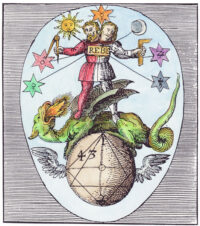Category: Ur Group
-
Esoterism and Christian Mysticism (5)
This is the concluding part of an essay originally published by EA, or Julius Evola, under the title “Esoterismo e Mistica Cristiana” from the third volume of Introduction to Magic. Here he discusses the the cult of Mary, the initiation of the Fedeli d’Amore, and then comes to a not unexpected conclusion. ⇐ Part 4…
-
Esoterism and Christian Mysticism (4)
This is part 4 of 5 of an essay originally published by EA, or Julius Evola, under the title “Esoterismo e Mistica Cristiana” from the third volume of Introduction to Magic. Here he discusses the gifts of the Holy Spirit, the tollhouses after death and the many correspondences between early Christianity and the mystery cults.…
-
Esoterism and Christian Mysticism (2)
This is part 2 of 5 of an essay originally published by EA, or Julius Evola, under the title Esoterismo e Mistica Cristiana from the third volume of Introduction to Magic. In this section he deals with the esoteric meaning of silence and homelessness. ⇐ Part 1 Part 3 ⇒ Anyhow, it will not be…
-
Esoterism and Christian Mysticism
This essay was originally published by EA, or Julius Evola, under the title “Esoterismo e Mistica Cristiana” from the third volume of Introduzione alla Magia. Obviously, Evola was quite interested in the topic since the essay runs to 20 pages and he was quite familiar with the secondary literature. The full translation will appear in…
-

The Alma Dancer
Alma Dancer Woman is not a “thing”, but an animal, which is worse: she is becoming a marionette, since that is what man liked. The aversion for woman, with that sacred fixation of “value”, is a modern obsession that proves the weakness of European man as ascetic and as warrior. The two attitudes that man…
-

Ascesis and Anti-Europe
This is authored by Havismat (Guido De Giorgio), from Volume 2 of Introduction to Magic. We see more of the paradoxical style of his writing. He reveals some personal details about his time in Tunisia and his experience with Sufis. See Short Note on Woman in East and West for an interesting note that was…
-
The Esoteric Origin of the Species (III)
This is the conclusion of essay originally which appeared in the Introduction to Magic, volume 3. The Diagram discussed is by Edgar Dacqué. He was a German paleontologist who was a devout Lutheran, a Theosophist, and was involved with the OTO. In this conclusion, Avro explains how man arises from the collective. He makes use…
-
The Esoteric Origin of the Species (II)
This essay originally appeared in the Introduction to Magic, volume 3. This is the second of multiple parts. It was published under the name “Avro”, which I believe to be Julius Evola. ⇐ Part 1 Part 3 ⇒ Moving from primitive man to the anthropoid and the ape, and presuming the jumps are surmountable, which therefore…
-
The Esoteric Origin of the Species
This essay originally appeared in the Introduction to Magic, volume 3. This is the first of multiple parts. It was published under the name “Avro”, which I believe to be Julius Evola. Part 2 ⇒ The reader will not fail to notice that in one particular point among others, the esoteric teachings have a distinctly…
-

The Arrow and the Rose
Reghini points to several other Hermetic symbols found in Dante and other writings of the Fedeli d’Amore. These include the Arrow, the Rose, the Rebis, the Azoth, and the Phoenix. Finally, he mentions the significance of the analogical or spiritual meaning of such texts, which simply cannot be understood by those not prepared for it.
